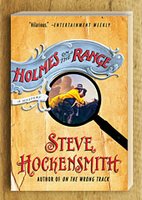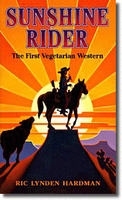
A few weeks ago, I experienced an uncontrollable urge to read some adult books. But when I went to the library, I found myself drawn to titles that had a young slant of one kind or another. I was drawn to Holmes on the Range by Steven Hockensmith because of the Sherlock Holmes connection. Traditionally, Holmes has been connected with young readers, though I'm not at all sure if he's of much interest to them these days.
Holmes on the Range has a marvelous premise. A cowboy is exposed to some Sherlock Holmes stories and becomes so enamored of them that he wants to take up deducing himself. The book has a wry, dry, and earthy wit, many engaging characters, and what appears to be an authentic setting. Is it a book of interest to the young? Well, for older teens and early twenty-somethings, I think it could be.
Otto and Gustav Amlingmeyer are cowboys who drift from one cowpunching job to another. Otto is twenty years old (young character!) and known as Big Red because he's the enormous red-headed brother. (Ho! as one character often says. Red-headed brothers! Red-headed League!) Gustav is twenty-seven and known as Old Red because he's the older red-headed brother. Gustav is a bright guy. More than bright, maybe. But he is totally illiterate. Only his "little" brother, the youngest and only surviving member of their family, learned to read and write. He reads and writes well enough, in fact, to have worked in a feed store as a teenager.
It is young Otto who reads the Sherlock Holmes stories aloud to his brother while they're around campfires or in the bunkhouse. And it is Gustav, whose crazy uncle taught him not to believe in the predestination that many of their German calvinist neighbors still subscribe to, who cannot accept that he will be nothing but a poor, ignorant cowboy. He wants to be more. He wants to be a detective like his hero, Sherlock Holmes. (Who is real in the world of this book, though he doesn't actually appear.) He sets out to find himself a case to solve and find one he does. Solving the case means real life or death for the two brothers, but for Gustav it means spiritual life or death as well.
By the end of the book, the Amlingmeyers, who have had no direction in their lives other than staying together, both have plans for a future. Who am I? What am I going to be? Sounds like a YA-related theme to me.
And, really, in spite of the rather impressive body count by the end of the story, Holmes on the Range is a hopeful book.
Now the book includes what some might call classic western situations and some might call western stereotypes--the European ranch owners, the eastern dudes, the cowpoke who can't speak to women. Whichever attitude you take, Hockensmith does fun things with them. On top of that, the last generation and a half didn't grow up on a steady diet of TV westerns. This may be new, fertile ground for them. Or, having no concept of the Old West in their psyches, they may feel too removed from it to be interested. It could go either way.
Don't hand this book off to some delicate thirteen-year-old looking to move up from Nancy Drew or the Hardy Boys, by the way. Hockensmith does some wonderful things with similis but a lot of them are built around the business of outhouses. The dead bodies are graphicly described. And some of the characters exhibit the racist attitudes you might expect of the 1890s. By no means are the black cowboys portrayed in a racist way. But there are a few racists among their compadres.

If you want a less adult but equally entertaining western for younger readers, try Sunshine Rider, The First Vegetarian Western by Ric Lynden Hardman. The book was quite buzzworthy back when it was published in 1998. And that was when there were nowhere near as many Internet sites to create buzz.
No comments:
Post a Comment